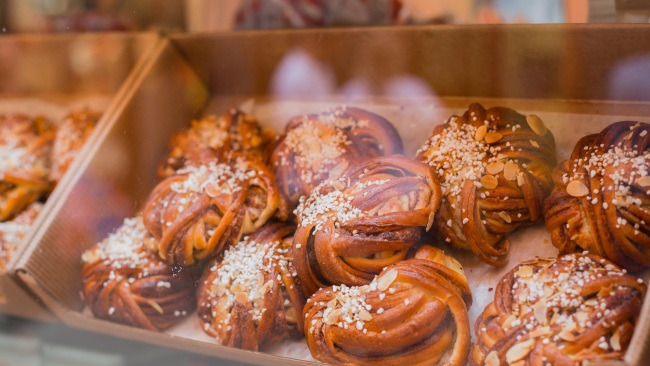All You Need to Know About the Fika Tradition in Sweden
A cozy coffee break – that’s what ‘fika’ means to Swedes. Many people love coffee. In fact, many would say that coffee is essential to their daily routines. And coffee is a central part of the Swedish custom known as fika.
But Fika is much more than just a coffee break – it’s a cultural institution. In Sweden, fika is a daily ritual. It is a time to take a break from work, meet friends, and enjoy good coffee and something to eat. And although fika can be enjoyed alone, it is often seen as a social event.
Fika: What Does It Mean?
The term “fika” traces its roots back to the 19th-century Swedish word for coffee, “kaffi.” The term later evolved as Swedes swapped the positions of the two syllables and dropped one of the “f” characters.
kaffi -> ffi-ka -> fika
Fika at the workplace
Fika is a regular part of many companies’ daily routines, with the most common time slots being 10:00 am and 3:00 pm. These breaks usually mean that employees gather for coffee, tea, and snacks.
In Sweden, taking a fika is also an accepted way for employees to connect with each other and learn from one another.
How is Swedish Fika Different from a Regular Coffee Break?
While both fika and coffee breaks can be a good way to relax and recharge during the workday, Swedish fika is something more. It’s a great way of connecting with others at the workplace, but also outside of work with friends and family.
The Swedish fika tradition goes beyond just taking a “coffee break.” It is incorporated into the Swede’s daily lifestyle and is an integral part of their culture.
Compared to your usual office coffee break, fika encourages more informal conversations that can create meaningful connections. People from all levels of an organization and different sectors can benefit from this professionally and personally.
What is on the Swedish Fika Menu?
 So what is typically served on a Swedish fika? A cup of coffee (or tea) goes without saying. But coffee is not all that matters you can also have soda or any other beverage of your choice – and still have an enjoyable fika!
So what is typically served on a Swedish fika? A cup of coffee (or tea) goes without saying. But coffee is not all that matters you can also have soda or any other beverage of your choice – and still have an enjoyable fika!
A typical Swedish fika break often includes pastries known as ‘fikabröd.’ – this can be everything from cinnamon buns to delicious biscuits.
Known as Prinsesstårta (Princess Cake) in Swedish, this cake is Sweden’s most popular and best-selling treat. It boasts a soft, light cake infused with vanilla cream and jam, all generously coated in layers of cream and marzipan. To top it off, this delectable delight is often adorned with a marzipan rose petal and icing sugar. Swedish Princess Cake is a staple in every Swedish confectionery.
Ultimately, the critical part of Swedish fika is not necessarily what items you eat but more about enjoying the time and company of others. Therefore, what you consume is less essential compared to the social aspect.
The History of the Fika Tradition in Sweden
Coffee first arrived in Sweden in the 1670s, but it wasn’t until a century later that it gained traction with the wealthy class. However, in 1746, an excessive tax was placed on this now-beloved beverage, and the Swedish people refused to pay it.
Despite the bans brought on coffee in Sweden after a decade, Swedes were still committed to their beloved coffee. As a result, taxes increased, leading to an illicit market of coffee consumption among the people.
King Gustav III was very anxious and believed drinking coffee could negatively impact human health. Consequently, he prohibited his people from drinking coffee. He was concerned that these clandestine coffee gatherings would contrive to dethrone the monarchy. As a result, he decided to utilize science to outlaw it in what has been referred to as the first clinical trial, it was pretty convenient for the King to have twin prisoners on hand for his experiment. They had been sentenced to death for their crimes, but he decided to commute their punishment and instead put them in life imprisonment in exchange for their participation in a health experiment.
One of the twin brothers consumed three cups of tea daily, while the other drank three cups of coffee daily. Surprisingly, both brothers outlived their healthcare advisors, and irony struck when the king passed away in 1792 before any outcome was declared.
In a strange twist of fate, the tea-drinking twin passed away first, dying at the age of 83. As a result, the ban was ineffective and it took only a short time for it to be revoked in the 1820s, which led to a tremendous surge in coffee consumption.
Today, the popularity of Swedish fika has spread beyond Sweden, with many cafes and bakeries around the world now offering their own version of the tradition. However, nothing quite compares to the authentic fika tradition in Sweden.
Coffee Consumption in Sweden
Swedes are coffee connoisseurs, surpassing other coffee-loving nations by consuming 7.6 kilos of coffee per person yearly. This equates to nearly 3 cups of coffee each day and places Sweden in third place among the most coffee-drinking countries in the world.
The combination of their love for coffee and the fika tradition makes for a unique and beloved aspect of Swedish culture. By embracing this tradition, Swedes have created a special way of connecting with each other and taking a moment to appreciate the simple joys in life.
The essence of Swedish fika lies in the simple act of taking a break and making time for friends. It is a cherished practice that encourages us to prioritize our well-being amidst the hustle and bustle of daily life. It is a good reminder to make time to connect with others and savor a delicious cup of coffee or tea. A simple lesson that would be good for all to partake in.
Swedish Translation Service
Swedish translation services are essential for businesses looking to expand into the Swedish market. A flawless translation that resonates with the Swedish audience is vital to achieving success in this market. Additionally, utilizing translation services shows your Swedish customers that your company values their business and wants to form a strong relationship with them.
Globalization Partners International (GPI) has extensive experience in the Swedish-speaking market, making us the ideal choice for all your Swedish translation needs. Our team of native Swedish translators understands how to effectively translate materials that are accurate, precise, and efficient, trust us to help you build a successful presence in the Swedish market.
